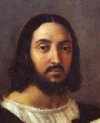|
Artist > Raphael (97 paintings.) |

Pandolfo Pico della Mirandola to Duchess Isabella Gonzaga of Mantua on Raphael, 1521.
Raffaello Santi, known as Raphael, or Raphael of Urbino, was born in Urbino on Good Friday 6 April 1483, the son of Magia di Battista di Nicola Ciarla and Giovanni Santi di Pietro. His father was a painter and poet at the court of Frederico da Montefeltre, one of the most famous princes and art patrons of Early Renaissance Italy. Raphael's father was not an outstanding painter, though he was a man of good sense. Raphael started helping out in Santi's studio at a very early age. It is believed that Raphael learnt the fundamentals of art in his father's studio. But it is still unclear where Raphael received his training after this early period in his father's workshop, as Giovanni Santi died in 1494. According to his first biographer Vasari Raphael was apprenticed to Perugino, although there are no sources, which confirm that he worked with Perugino before 1500. Among Raphael's early works, we know about Baronci Altarpiece, which was commissioned in 1501. It was badly damaged in an earthquake in 1789 and only some of its sections survived and now are kept in different collections. All Raphael's surviving works from 1502 to 1504 show Perugino's influence, the most notable are Crucifixion (1502-1503), Coronation of the Virgin (c.1503-1504), Marriage of the Virgin (1504), St. George (c.1504), St. Michael (c.1503-1504), The Three Graces (c.1503-1504), Allegory (The Knight's Dream) (c.1503-1504), Madonna and Child (c.1503), Madonna Connestabile (c.1503-1504).
In 1504, Raphael moved to Florence, where he remained until 1508. These years were very important for his development. He studied works of Leonardo da Vinci and Michelangelo there, by which he was greatly influenced. Yet he proved, that his ability to adapt from others what was necessary to his own vision and to reject what was incompatible with it was faultless. In Florence he started his series of Maddonnas, whose charm has captured popular imagination ever since: Madonna del Granduca (c.1505), Madonna of the Meadow (1505 or 1506), Madonna with the Goldfinch (c.1506), La Belle Jardiniere (1507 or 1508). He created several portraits, which also had Leonardo's impact Portrait of Agnolo Doni (c.1506), Portrait of Maddalena Doni (c.1506), Portrait of a Lady with a Unicorn (1505-1506), Portrait of a Pregnant Woman (c. 1506). Other notable pictures from his Florence period are St. George and the Dragon (c.1505-1506), Entombment (1507), St. Catherine (c. 1508), Madonna with the Baldachino (1507-1508).
Within four years Raphael had achieved success in Florence and his fame had spread abroad. By the autumn of 1508, he was in Rome and was entrusted by Pope Julius II with the decoration of the Stanze, the new papal apartment in the Vatican Palace, an enormous commission for the 26-year-old artist. It was nevertheless a triumph. The first room Stanza della Segnatura was completed by 1511. This room was probably Julius II's private library and it was decorated in the traditional way of decorating libraries, which went back to the Middle Ages. Each of the four walls was allocated one faculty from the spectrum then available: Theology, Philosophy, Poetry and Jurisprudence (as Justice) and presented as female figures. They all appear in four large tondi on the ceiling. Along the walls are allocated to them the appropriate images of men and women from history who had won fame in each of these fields. The School of Athens (1509) as the depiction of philosophy and Disputa (Disputation over the Sacrament) (1510-1511) as the depiction of theology are a culmination of High Renaissance principles. They stand for the intellectual reconciliation of Christianity and classical antiquity. Both frescos are miracles of harmony, of movement within strict symmetry, of the union of the real and the ideal.
The second room was Stanza di Eliodora, named after the main fresco The Expulsion of Heliodorus (c.1512), on which Raphael worked from 1511 till 1514. The general theme of the room is that of God's intervention in human destiny. The third room Stanza dell'Incendio was probably finished by his assistants after his sketches in 1514-1517. Other important commissions in this period include The Triumph of Galatea (c. 1511) for Villa della Farnesina, frescoes for the church of Saint'Agostino, frescoes for the Sala di Costantino and the decoration of Loggie of Vatican Palace.
Under the new Pope Leo X Raphael held an important position in the papal court. Besides combining positions of painter, architect (he was Chief Architect of St. Peter's cathedral) and archeologist, he initiated the first comprehensive survey of the antiquities of Rome. Although Raphael's main task during this period was to decorate Stanza, he still found time for a subject, which preoccupied him for a long time: Madonna and Christ Child. He created Madonna Alba (1511-1513), Madonna della Tenda (c. 1512-1514), Madonna della Sedia (1512-1514), Madonna di Foligno (c.1511-1512) and the most famous of all Sistine Madonna (c.1513-1514). The most notable portraits of this period were Portrait of a Cardinal (1510-1511), Portrait of Tommaso Inghirami (c.1511), Portrait of Pope Julius II (c.1512), Portrait of Baldassare Castiglione (c.1514-1516), La Donna Velata (c. 1514-1516), Portrait of Pope Leo X with Cardinals Giulio de' Medici and Luigi de' Rossi (1513-1519). He created 10 cartoons for the tapestries, ordered by Leo X for the Sistine Chapel, 7 of which have survived and now in Victoria and Albert Museum in London. The tapestries themselves were woven by Pieter van Aelst and are now in the Vatican Museums.
The Transfiguration (c.1519-1520), was the last work Raphael painted. It was commissioned by Cardinal Giulio de' Medici. Raphael died unexpectedly on Good Friday 6 April 1520. The Transfiguration was complete. Vasari wrote: "He was laid out in the room where he last worked, and at his head hung his painting of the transfigured Christ, which he completed for Cardinal de' Medici. The contrast between the picture, which was so full of life, and the dead body filled everyone who saw it with bitter pain."